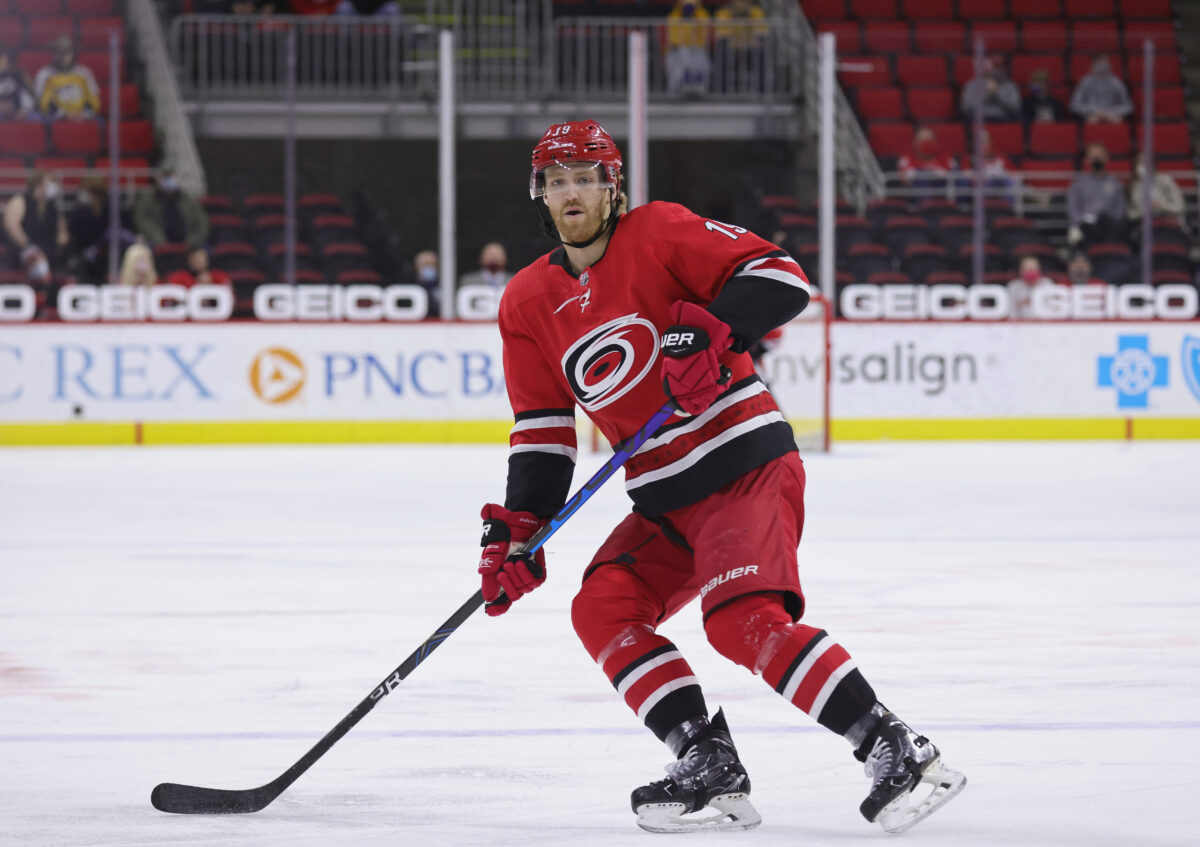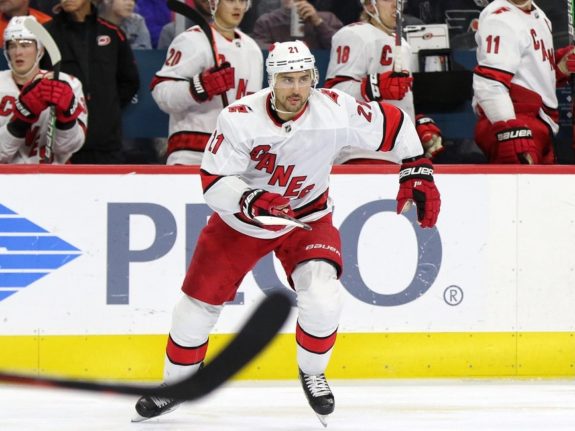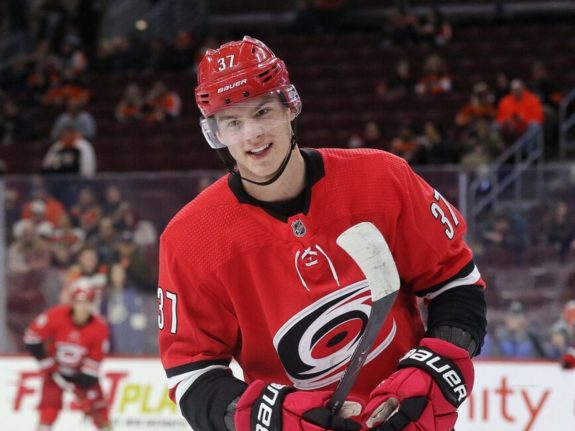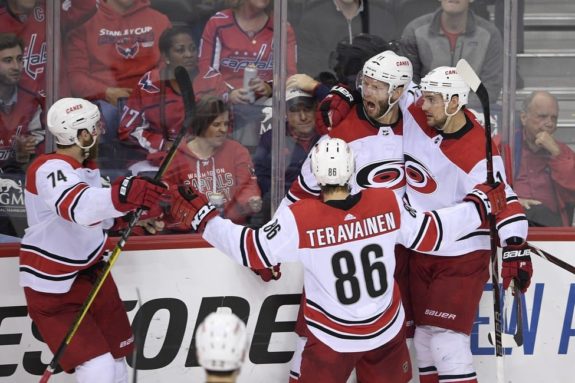I know it’s painful, and it hurts to write this myself, because this wasn’t the way it was supposed to go.
The Hurricanes had arrived. This was the year; first place in the division ahead of the Tampa Bay Lightning, one of the best records in all of hockey, and a stacked roster with depth at all three levels. Consecutive postseason defeats at the hands of the Boston Bruins had given them the experience they needed, and young stars like Sebastian Aho, Andrei Svechnikov, and Martin Necas had fought through their growing pains. A young star burst onto the scene in net in Alex Nedeljkovic. Veteran acquisitions such as Vincent Trocheck, Brady Skjei, and Jesper Fast filled holes and brought imperative dynamics the team needed. They were ready for a Stanley Cup run. Or, at least, so we thought.
But then, the fully-healthy Lightning happened. There is no shame in that.
The Hurricanes are still close, which makes this an enormous offseason for the front office. Svechnikov, Dougie Hamilton, multiple depth players, and every NHL-roster goaltender are set to be a free agent. The same goes for the head coach – a fascinating storyline to follow, as Rod Brind’Amour has breathed life into an irrelevant franchise. Losing him would be a huge slap in the face to not only the fans but every member of the organization, including the players. Of course, that’s highly unlikely to happen, but with Brind’Amour holding out for his assistants, it’s at least something to monitor.
But we have plenty of time to go in-depth into all of that in the next few weeks, as a long (but also short, by regular off-season standards) summer lies ahead. So, for now, let’s look at three reasons the Hurricanes and their fans should still be extremely excited for the future.
The Youth
Let’s start with the most obvious one – the Hurricanes still have an incredible young core with the potential to go on a massive run of contention in the near future.
Now I will say, the idea of “early in their window” is fool’s gold. A lot of things went right for this year’s Hurricanes. Trocheck was a monster, Jordan Staal had an offensive renaissance at age-32, Nedeljkovic far outplayed his AHL numbers, and the list goes on. Who knows if any of those players will even come close to their 2020-21 outputs next season? What if the injury bug bites hard? What if Dougie Hamilton walks, and the Hurricanes don’t find a viable replacement? This was my reasoning for thinking the Hurricanes to get aggressive at the trade deadline in the first place. If you have a chance to win a Stanley Cup, you should always do your best to maximize your chances, although I understand the hesitancy in handicapping yourself for the future. It’s a fine line to try to balance.

Back to the point, and regardless of the above disclaimer, the Hurricanes are right on the cusp. Svechnikov had a tough, up-and-down year but is still primed for superstardom at just 21 years of age. He will get a lot better once he matures a little, mostly between the ears; he has much to learn about playing with the edge that makes him unique, without the lack of discipline that bit the Hurricanes quite a bit this year. In addition, he is still figuring out how to best take advantage of his unbelievable physical tools at the NHL level as well.
Down the line, Necas is only 22, and even Aho, though the oldest of that trio of rising stars, is just 23. All of these players could conceivably find another gear, and all will be under team control in the next few years. Backing them up are Jaccob Slavin, Brett Pesce, and Brady Skjei, who make up 75% of a fantastic top-four on the blue line. It’s simply an incredible core to continue growing together over the next half-decade or so.
That youth ultimately seemed to do Carolina in. However, they still didn’t seem totally comfortable in the postseason, and that comfort level only comes with the experience of being there and trial-by-error. For example, the little things a team has to do in the playoffs – capitalizing on mistakes such as penalties and turnovers, winning key faceoffs, and finishing Grade-A chances – were areas the Lightning dominated. I can remember at least three empty nets the Hurricanes were unable to finish into; it’s really tough to beat Vasilevskiy, to begin with, you simply cannot waste those opportunities. Furthermore, when the Hurricanes took a 4-2 lead in Game 4, with a chance to even the series headed back to home ice, the team just completely lost sight of their identity, which was a direct sign of their immaturity.
They seemed to get excited almost, began running around, badly out of position, and lost their discipline instead of trusting what got them there and not pressing the play. Meanwhile, the Lightning, never devoid of composure, waited for those mistakes to come, pounced with timely power-play goals, and finished off a period the Hurricanes scored four times on them, on likely the best goalie in the world, with a 5-4 advantage. I didn’t want to say it, but a part of me knew at that moment the series was likely over.
Despite a lackluster effort facing elimination in Game 5, the Hurricanes should look back on this series and know their roster went toe-to-toe with the defending champions and that youthful exuberance should carry over into excitement in opportunities to get another shot at Tampa Bay in the coming years.
And, lastly, while on the subject of the coming years, the team has even more reason for optimism beyond what was mentioned above. The Hurricanes still possess a sublime farm system, rife with prospects that will continue to supplement the big club over the next few years. In addition, electrifying forwards like Seth Jarvis, Jamieson Rees, Ryan Suzuki, Tuukka Tieksola, and many others should fill some of the depth roles with legitimate offensive threats – a problem that reared its head during the series, as the secondary scoring was nigh-nonexistent. Very few teams have the combination of a deep pipeline and talented, young NHL roster already proving to be a legitimate threat – I’d wager many, many teams in the league would absolutely love to swap places and possess the Hurricanes’ future outlook right now.
The Results
Yes, it was a five-game series. The Hurricanes only got one win; in that sense, the series wasn’t particularly close. But dig a little deeper and you’ll see – a break here and there, and we could be talking about this in very a different light.
In each of the first two games, the Hurricanes were arguably the better team. They simply got Andrei Vasilevskiy’d, scoring just twice on 70 shots on goal. Of course, shot totals alone can be misleading, and the Hurricanes have been known as Corsi savants for years now. Still, even by Natural Stat Trick’s expected goals (xGF) tally, the series was about as even as could be – Tampa Bay held a 9.49 to 9.12 advantage in xGF, or a 51%-49% expected goals percentage (xGF%).
When considering these things, also think back to an excerpt from my Game 3 recap: “So much about the postseason is things breaking right; getting a bounce that ends up in the net, players catching fire at the right time, or simply just good injury luck. For much of this postseason, things have certainly not gone like that for the Hurricanes in any of those areas.”

I don’t mean to suggest the Lightning getting lucky or the Hurricanes not decided the series. Still, Carolina certainly didn’t get the injury luck they needed to match up with the defending champions. Being without a fully healthy Trocheck or Nino Niederreiter was a massive blow to the team, and neither look himself despite returning to the lineup for Game 5. Trocheck admitted to the media in his exit interview that he was dealing with a sprained MCL, which can’t be particularly fun playing through during a hockey game.
And look, I’m not complaining about the Lightning’s salary cap whatsoever. However, the fact is that it was almost 20% higher than cap hit of the Hurricanes. It wasn’t illegal, so power to them, but it’s something the league should probably take a look at. I bring it up because it is another example of how close to true contention the Hurricanes are. The Lightning had, in a way, an unfair advantage in their ability to add players they otherwise wouldn’t have been able to to help them get to the postseason when their roster cap hit suddenly was able to jump to nearly $100 million. Yet, the Hurricanes hung tough and played four excellent games in which they had a chance to win each of them. It will look like a short series in the history books, but those who watched closely know this team battled and was right there.
The Opportunity Ahead
I said it earlier – this is a massive off-season for the regime and could potentially define their tenure. As extreme as it sounds, that’s not an exaggeration.
The Hurricanes chose to stand pat, or at the very least didn’t aggressively pursue the market for an upgrade, at the trade deadline. Unfortunately, it came back to bite them. Suppose you take a look around the league, almost every other team with a shot at contending made a move to bolster their roster, except Carolina. Judging off of Waddell’s tenure up to this point, and with the team’s salary cap situation potentially looking much more manageable despite the flat cap for 2021-22, the front office has a chance to spice things up and push this team over the top – if they can find the right moves to pull the trigger on.
It feels like the Hurricanes are three moves away from a potentially Tampa Bay-esque run of heavy contention. The first, and hopefully easiest, is simply Svechnikov returning to the trajectory he showed in his sophomore season, where he posted 24 goals (two of them lacrosse style, in case you forgot) and 61 points in 68 games. He was an absolute force, and putting forth that kind of season, mostly still as a teenager, put the league on notice. The following year growing pains were unfortunate, but with his talent level and work ethic, there’s no reason to think he didn’t just have a delayed sophomore slump that will soon be a distant memory. Put it this way:
Nathan MacKinnon, first three seasons: 59 goals, 153 points in 218 games, an average of 0.27 goals, and 0.70 points per game.
Andrei Svechnikov, first three seasons: 59 goals, 140 points in 205 games, an average of 0.29 goals, and 0.68 points per game.

MacKinnon was solid in his fourth year and didn’t break out until year five, which is entirely plausible for Svechnikov as well. Either way, I think the Russian sniper can absolutely follow that path and turn into a top-5-ish player in the league sooner than later, like his fellow top pick from Colorado.
The other two are simple additions: one on defense and at forward. The defense is obviously the team’s strength, but the third pairing was a problem at times this season. I don’t foresee Hamilton leaving, as the organization realizes how imperative his contributions are, even if his postseason play has fallen short of that lofty standard. Meanwhile, Jani Hakanpää is set to be a free agent as well, and with his return unlikely, the Hurricanes need to find a third-pairing, preferably-right-shot defenseman to play with Jake Bean.
A stable partner next to the young offensive defenseman could be a boon for the Hurricanes, as Bean looked substantially better opposite Brett Pesce than pretty much any other time he has in the NHL. A sturdy, stay-at-home defenseman, even if a player anywhere near Pesce’s actual talent level is likely a pipe dream, could theoretically round out the Hurricanes defensive pairs. If Bean can break out next to a solid partner, that unit will be absolutely stacked.
At forward, the question, and theoretical answer, is a tad more obscure. The question alone – “what will the Hurricanes do in their forward ranks” – could (and very well may at some point) make for its own post. For now, the simple rundown is this: the Hurricanes have the following free agent forwards: Jordan Martinook, Warren Foegele (restricted), Brock McGinn, and Cedric Paquette.
That’s a decent chunk of their bottom-six from the previous season. Martinook is an alternate captain and huge piece of the locker room, but his on-ice production leaves much to be desired. Foegele brings a lot of energy and the occasional offensive outburst, but his spot could logically be targeted for an upgrade. Paquette is almost certainly a goner, and Brock McGinn seems highly likely to be re-signed as a quintessential Brind’Amour player, laying it all on the line each shift and taking care of his own end first.
Theoretically, the Hurricanes would have cap space freeing up by letting some of these players walk – as well as the $2.3 million that will be available from Alexander Semin’s infamous buyout officially coming off the Carolina books. In addition, there is another approximately $2 million that will be gone from retained salary from Ryan Dzingel, Haydn Fleury, and Hurricanes legends Patrick Marleau and Alex Galchenyuk. As things currently stand, the team will have around $28 million in cap space this summer. Take out approximate deals for Hamilton, both Nedeljkovic and a backup goaltender, Svechnikov (probably on a bridge deal), and McGinn, and that number will probably be closer to $10-$12 million.
That’s plenty of space to add a bottom-pair or second pairing-level defenseman and at least one good, difference-making, top-six goal scorer, which is what I would be targeting if I were Hurricanes General Manager Don Waddell. Their lack of depth scoring was painfully obvious in the Tampa Bay series, and, even if things break right again in 2021-22, the Hurricanes could use another player to put the puck in the net if they truly expect to contend.
Latest Hurricanes Content:
- Hurricanes’ 2024-25 Pipeline: Illinois to Carolina
- Hurricanes Mailbag: Season Outlook, Roster Moves & Strength of Schedule
- Maniscalco Discusses the Hurricanes’ Offseason Moves, Management & More
- Max Comtois Headed for KHL, What Went Wrong During NHL Stint?
- NHL Rumors: Oilers, Hurricanes, Senators
Again, I didn’t want to dig too far into this one, as plenty of management discourse is forthcoming over the next few months. And keep in mind, I didn’t even mention the upcoming Seattle Kraken expansion draft, which will surely impact a Hurricanes roster possessing more good players than protection slots – a touch different from the last time around with Vegas. However, one thing I will say for the event – Don Waddell has proven to be a shrewd businessman, and the expansion draft could be an opportunity for him to pry a player away whose team will be unable to protect them.
Similar to a trade deadline rental, a “get something or lose him for nothing”-type scenario. I expect this to be a very chaotic summer all around for basically every team, so the Hurricanes should try to have their noses right in the middle of all the transacting. With all the expiring contracts and league-wide roster shuffling the expansion draft will incite, this summer presents a solid opportunity to ice a much-improved lineup this October in Carolina.

This season certainly didn’t end the way Hurricanes players, coaches, front office, and fans envisioned. I objectively believed they had a shot at making a run myself. In fairness, getting knocked out in the second round doesn’t make that untrue. The Stanley Cup run just wasn’t in the cards for this franchise – yet.
Focus on that last word for now, as the future remains very bright. This is a fantastic, young team with a ton of potential both on the roster and in the pipeline, and behind one of the best head coaches in hockey, don’t expect this franchise to go anywhere anytime soon. It’s going to be a fascinating summer with the NHL Draft, a free agent class with some extremely intriguing names, the “Worldwide Leader” (ESPN, if you’ve never heard that phrase associated with them before) taking back over as the primary platform for the NHL, and, of course, a new franchise entering into the National Hockey League, and I can’t wait to see which direction this regime decides to take the roster.
As tough as it was to watch the Hurricanes sulk off the ice after a series defeat to the Lightning, I can assure you one thing: the best is yet to come.